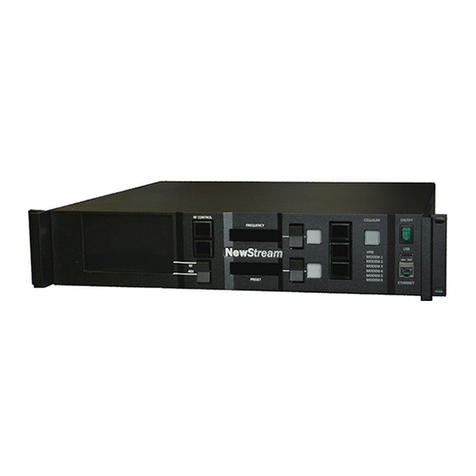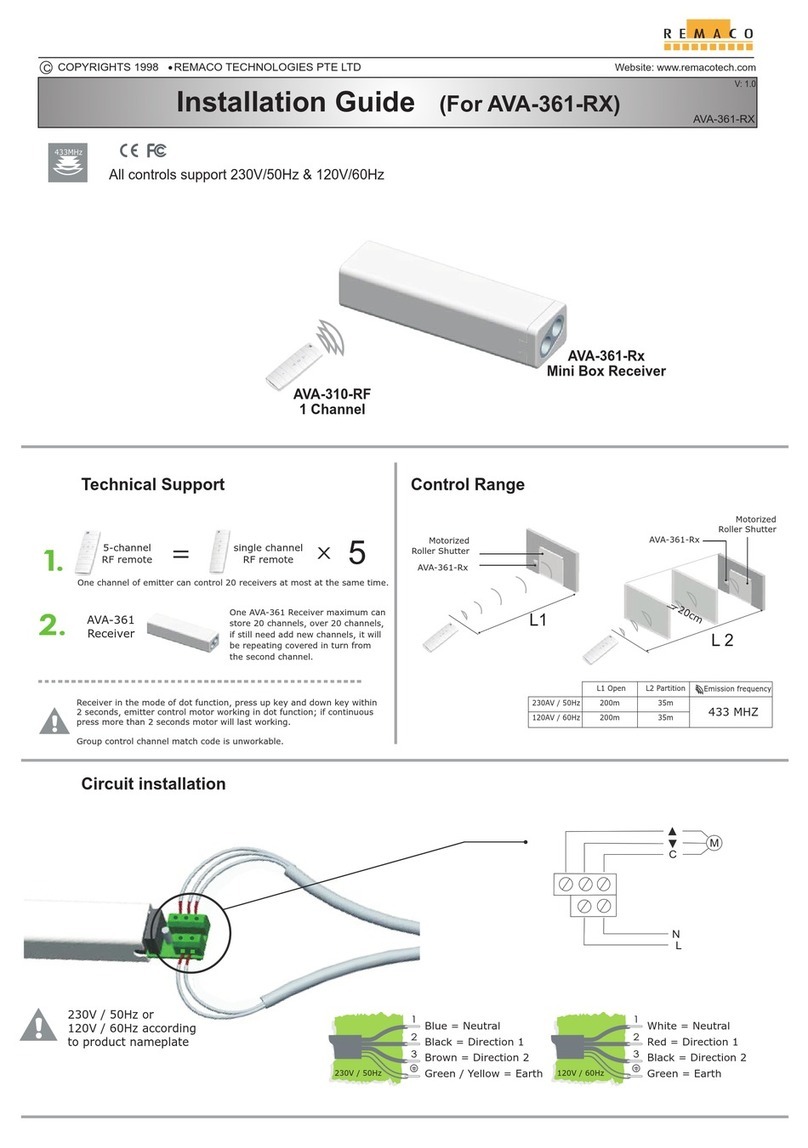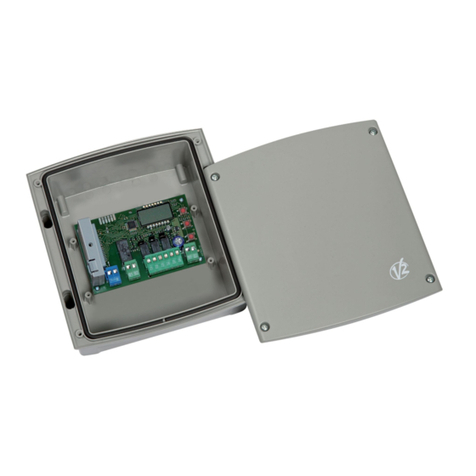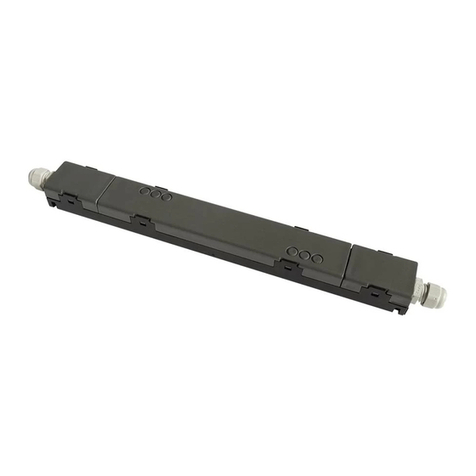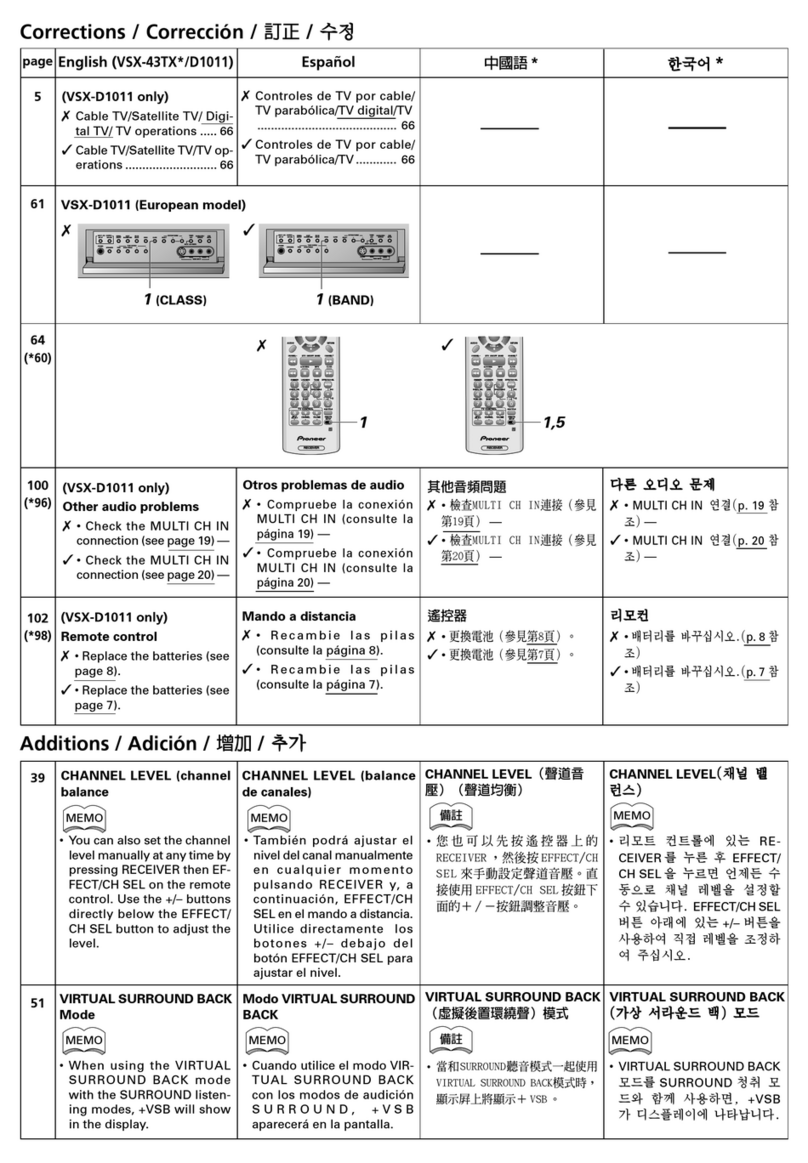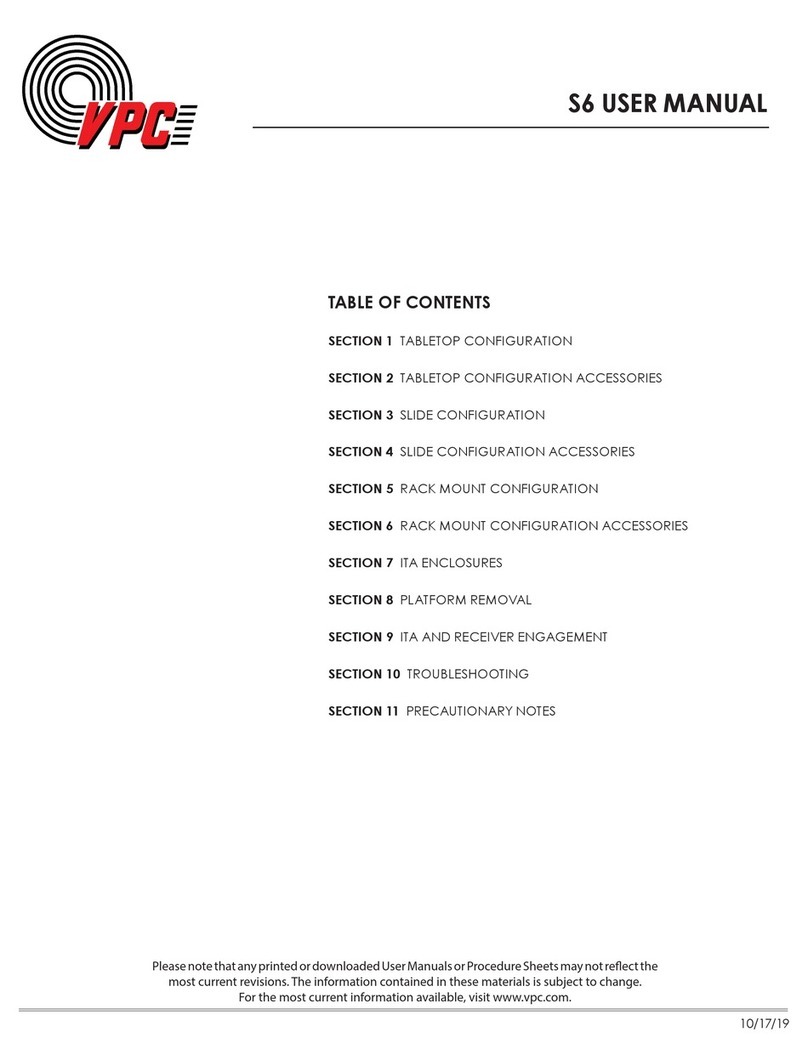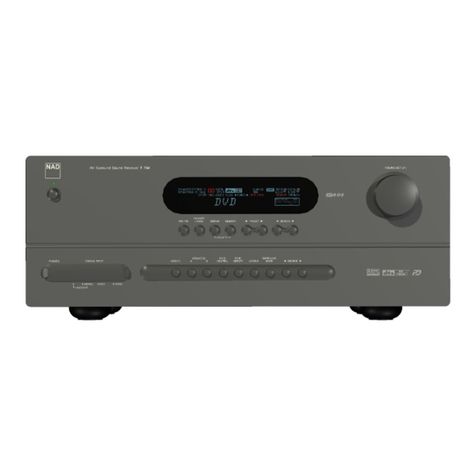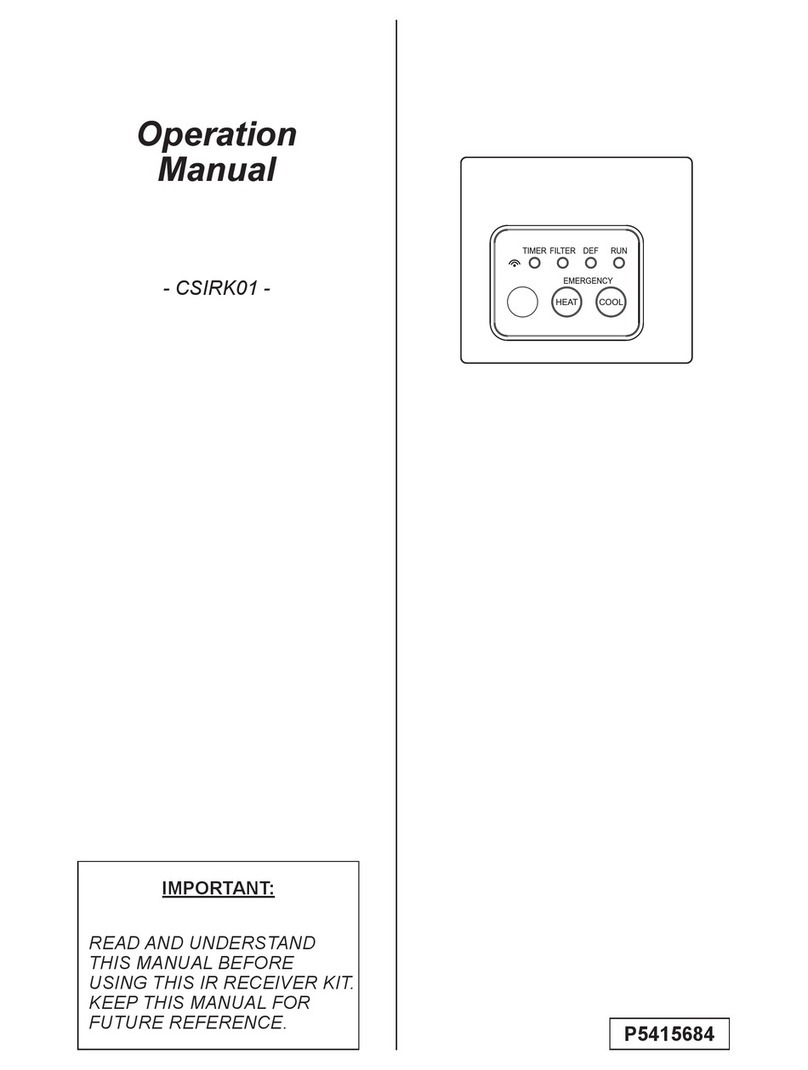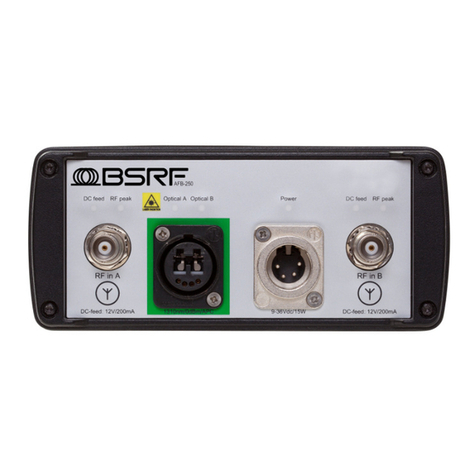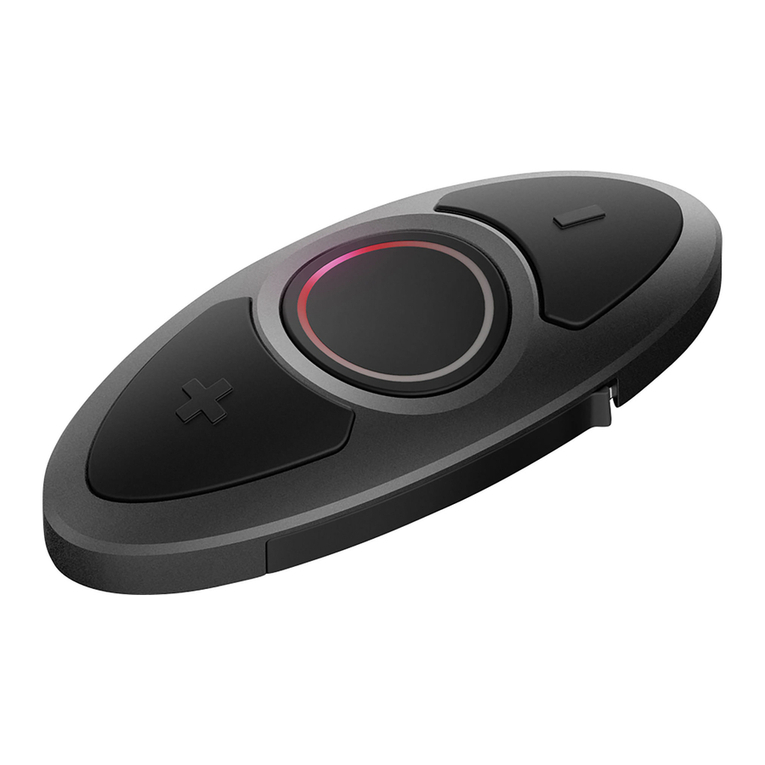Vislink Strata RX Product manual

Strata RX
System
Analog+Digital
Portable
Microwave Receiver
Technical
Reference
Manual
RXU
RX
AUDIO SIGNAL OUTPUT PWR/RS-485
PWR
STRATA
STRATA
RCU
RCU
RX
RX
DC
DC
ON COAX
ON COAX
OFF
OFF
ON
ON
STRATA
STRATA
Manual Part No. 400495-2
Rev. A July 2004


Notices iStrata RX Technical Reference Manual
Notices
About This Manual
Part number 400495-2
Revision A --- July 2004
Supercedes # 400495-1 Rev. 2.8 November 2003
The information in the manual applies to the Strata RX System.
Copyright
The information in this book may be reproduced by the
purchaser to the extent needed for their organization. No part of
this material may be modified in any way or published for resale
without the express written authorization of Vislink plc.
© 2004 Vislink plc
Worldwide Headquarters:
Vislink plc
Nashleigh Hill,
Chesham,
Buckinghamshire,
HP5 3HE,
England
Tel: + 44 (0)1494 774400
Fax: + 44 (0)1494 791127
US Support Centre:
Microwave Radio Communications
101 Billerica Avenue - Bldg. 6
North Billerica, MA 01862-1256USA
TEL: 978.671.5700
FAX: 978.671.5800
Printed in U.S.A.

Notices iiStrata RX Technical Reference Manual
Proprietary Material
The information and design contained within this manual was
originated by and is the property of Vislink plc. Vislink plc
reserves all patent proprietary design, manufacturing,
reproduction use, and sales rights thereto, and to any articles
disclosed therein, except to the extent rights are expressly
granted to others. The foregoing does not apply to vendor
proprietary parts.
To allow for the introduction of design improvements,
specifications are subject to change without notice.
Conventions
Pay special attention to information marked in one of the
following ways:
CAUTION Follow CAUTIONS closely to prevent
personal injury or death.
WARNING Follow WARNINGS to prevent damage to
the equipment.
Note Notes provide additional information to assist you
in using and maintaining the equipment.
On-Line Viewing
Text displayed as blue contains a hypertext link. Click on the
hypertext to jump to that destination. Click on the
blue destination to return.
Viewing this manual on-line
requires Adobe Acrobat,
version 4.0 or above.
Click on this icon to download your
FREE copy of Adobe Acrobat
Reader.

Notices iiiStrata RX Technical Reference Manual
Symbols Used
The following symbols are used on the equipment:
Symbol Meaning
CAUTION: Risk of Electric Shock
WARNING: General Warning. Risk of Danger
WARNING: Electrostatic Discharge. Possible
Damage to Equipment
Fuse - Identifies fuses or their location.
Frame or Chassis Ground - Identifies the frame or
chassis terminal.
Earth Ground - Identifies the earth Ground Terminal
Protective Earth Ground - Identifies any terminal
which is intended for connection to an external
conductor for protection against electric shock in
case of a fault, or the terminal on a protective earth
electrode.
Warranty Information
Product Manufactured by Vislink:
a. Products manufactured by Vislink are warranted against
defects in material and workmanship for a period of two (2) years
from date of delivery as evidenced by Vislink's packing slip or
other transportation receipt (unless otherwise noted).
b. Vislink's sole responsibility under this warranty will be to
either repair or replace, at its option, any component which fails
during the applicable warranty period because of a defect in
material or workmanship, provided Buyer has promptly reported
same to Vislink in writing. All replaced products and parts will
become Vislink's property.
c. Vislink will honor the warranty at the repair facility designated
by Vislink. It is Buyer's responsibility to return, at its expense, the
allegedly defective product to Vislink. Buyer must obtain a
Return Material Authorization (RMA) number and shipping
instructions from Vislink prior to returning any product under
warranty. Transportation charges for the return of the product to
Buyer will be paid by Vislink within the United States. For all
other locations, the warranty excludes all costs of shipping,
customs clearance and other related charges. If Vislink
determines that the product is not defective within the terms of
this warranty, Buyer will pay Vislink all costs of handling,
transportation and repairs at the then prevailing repair rates.
d. All the above warranties are contingent upon proper use of
the product. These warranties will not apply (i) if adjustment,
repair, or product or parts replacement is required because of
accident, unusual physical, electrical or electromagnetic stress,
neglect, misuse, failure of electric power, environmental controls,
transportation, failure to maintained properly or otherwise in
accordance with Vislink specifications, or abuses other than

Notices ivStrata RX Technical Reference Manual
ordinary use; (ii) if the product has been modified by Buyer or
has been repaired or altered outside Vislink's repair facility,
unless Vislink specifically authorizes such repairs or alterations
in each instance; or (iii) where Vislink serial numbers, warranty
data or quality assurance decals have been removed or altered.
e. No person, including any dealer, agent or representative of
Vislink is authorized to assume for Vislink any other liability on its
behalf except as set forth herein. If any payment is due Vislink
for services performed hereunder, it will be subject to the same
payment terms as the original purchase.
Products Manufactured By Others:
For products not manufactured by Vislink, the original
manufacturer's or licensor's warranty will be assigned to Buyer to
the extent permitted by the manufacturer or licensor and is in lieu
of any other warranty, expressed or implied. For warranty
information on a specific product, a written request should be
made to Vislink.
All Products:
THE FOREGOING WARRANTIES AND REMEDIES ARE
EXCLUSIVE AND ARE IN LIEU OF ALL OTHER EXPRESS OR
IMPLIED WARRANTIES, OBLIGATIONS, AND LIABILITIES ON
THE PART OF VISLINK. EXCEPT FOR THE EXPRESS
WARRANTIES STATED HEREIN, VISLINK DISCLAIMS ALL
WARRANTIES ON PRODUCTS FURNISHED HEREUNDER,
INCLUDING, WITHOUT LIMITATION, ALL IMPLIED
WARRANTIES OF MERCHANTABILITY AND FITNESS FOR A
PARTICULAR PURPOSE. VISLINK WILL HAVE NO
RESPONSIBILITY FOR ANY PARTICULAR APPLICATION
MADE OF ANY EQUIPMENT. Any description of equipment,
whether in writing or made orally by Vislink or its agents,
specification sheets, models, bulletins, drawings, or similar
materials used in connection with Buyer's order are for the sole
purpose of identifying the equipment and will not be construed as
an express warranty. Any suggestions by Vislink or its agents
regarding use, application or suitability of the equipment will not
be construed as an express warranty. No warranties may be
implied from any course of dealing or usage of trade. Buyer
agrees that the exclusion of all warranties, other than those
expressly provided herein, is reasonable.

Contents vStrata RX Technical Reference Manual
Contents
Notices - - - - - - - - - - - - - - - - - - - - - - - - - - - - - - i
About This Manual - - - - - - - - - - - - - - - - - - - - - - - - i
Copyright- - - - - - - - - - - - - - - - - - - - - - - - - - - - - - - i
Proprietary Material - - - - - - - - - - - - - - - - - - - - - - - ii
Conventions - - - - - - - - - - - - - - - - - - - - - - - - - - - - - - - ii
On-Line Viewing- - - - - - - - - - - - - - - - - - - - - - - - - - ii
Symbols Used- - - - - - - - - - - - - - - - - - - - - - - - - - - - - - iii
Warranty Information - - - - - - - - - - - - - - - - - - - - - - - - - iii
Product Manufactured by Vislink: - - - - - - - - - - - - - - iii
Products Manufactured By Others:- - - - - - - - - - - - iv
All Products: - - - - - - - - - - - - - - - - - - - - - - - - - - - iv
Contents - - - - - - - - - - - - - - - - - - - - - - - - - - - - - v
Introduction - - - - - - - - - - - - - - - - - - - - - - - - - 1-1
Chapter Overview - - - - - - - - - - - - - - - - - - - - - - - - - 1-1
What This Manual Covers - - - - - - - - - - - - - - - - - - - 1-1
How It’s Organized - - - - - - - - - - - - - - - - - - - - - - - - 1-1
Who It’s Written For - - - - - - - - - - - - - - - - - - - - - - - - 1-1
Related Documents - - - - - - - - - - - - - - - - - - - - - - - - 1-1
Ordering documentation- - - - - - - - - - - - - - - - - - - - - 1-2
Calling for Service - - - - - - - - - - - - - - - - - - - - - - - - - 1-2
Supported Repairs - - - - - - - - - - - - - - - - - - - - - - - - 1-2
Tell Us What You Think! - - - - - - - - - - - - - - - - - - - - 1-3
Product Description- - - - - - - - - - - - - - - - - - - 2-1
Chapter Overview - - - - - - - - - - - - - - - - - - - - - - - - - 2-1
System Description - - - - - - - - - - - - - - - - - - - - - - - - 2-1
RF and Demodulation Options - - - - - - - - - - - - - - 2-1
Antenna and Power Options - - - - - - - - - - - - - - - 2-3
Mounting and Deployment Options - - - - - - - - - - 2-4
System Integration - - - - - - - - - - - - - - - - - - - - - - 2-4
System Components - - - - - - - - - - - - - - - - - - - - - - - 2-4
Strata RXU - - - - - - - - - - - - - - - - - - - - - - - - - - - - 2-5
Strata RCU - - - - - - - - - - - - - - - - - - - - - - - - - - - - 2-5
Controls and Connections - - - - - - - - - - - - - - - - - - - - 2-5
Typical System Configurations - - - - - - - - - - - - - - - - 2-6
For More Information - - - - - - - - - - - - - - - - - - - - - - 2-14
Routine Operation - - - - - - - - - - - - - - - - - - - - 3-1
Chapter Overview - - - - - - - - - - - - - - - - - - - - - - - - - 3-1
Overview of Controls - - - - - - - - - - - - - - - - - - - - - - - 3-1
Power Switch - - - - - - - - - - - - - - - - - - - - - - - - - - 3-1
Status LED - - - - - - - - - - - - - - - - - - - - - - - - - - - - 3-2
Alphanumeric Display - - - - - - - - - - - - - - - - - - - - 3-2
Control Switch- - - - - - - - - - - - - - - - - - - - - - - - - - 3-2
Using the Strata RX Screens - - - - - - - - - - - - - - - 3-3
DC on Coax Switch - - - - - - - - - - - - - - - - - - - - - - 3-4
Preparing for Operation - - - - - - - - - - - - - - - - - - - - - 3-6
Setting Up - - - - - - - - - - - - - - - - - - - - - - - - - - - - 3-6
Turning the power ON and OFF - - - - - - - - - - - - - 3-8
Monitoring Operation - - - - - - - - - - - - - - - - - - - - - - - 3-9
Using the Monitor Screens in Ext IF Mode - - - - - - 3-9
Using the Monitor Screens in Analog Mode - - - - - 3-9
Using the Monitor Screens in Digital Mode- - - - - 3-10
Monitoring Link Quality (LQ) - - - - - - - - - - - - - - 3-13
LQ Action Levels - - - - - - - - - - - - - - - - - - - - - - - 3-14
What Actions to Take- - - - - - - - - - - - - - - - - - - - 3-14
Monitoring Bit Error Ratio (BER) - - - - - - - - - - - 3-16
Monitoring Signal-to-Noise Ratio (SNR)- - - - - - - 3-17
Changing Settings - - - - - - - - - - - - - - - - - - - - - - - - 3-18
Selecting a Preset - - - - - - - - - - - - - - - - - - - - - 3-18
Selecting a Channel - - - - - - - - - - - - - - - - - - - - 3-20
Selecting a Band - - - - - - - - - - - - - - - - - - - - - - - 3-21
Selecting the IF Filter - - - - - - - - - - - - - - - - - - - 3-22
Setting the Monitor Output - - - - - - - - - - - - - - - - 3-23
Setting the Squelch Level - - - - - - - - - - - - - - - - 3-24
Setting the COFDM Bandwidth - - - - - - - - - - - - 3-25

Contents viStrata RX Technical Reference Manual
Controlling DC Power on Coax - - - - - - - - - - - - 3-26
Front Panel Menu Maps- - - - - - - - - - - - - - - - - - - - 3-27
Front Panel vs. Configurator Settings - - - - - - - - - - 3-30
Troubleshooting - - - - - - - - - - - - - - - - - - - - - 4-1
Chapter Overview - - - - - - - - - - - - - - - - - - - - - - - - - 4-1
Status LED - - - - - - - - - - - - - - - - - - - - - - - - - - - - - - 4-1
Messages on Display- - - - - - - - - - - - - - - - - - - - - - - 4-2
Error Codes - - - - - - - - - - - - - - - - - - - - - - - - - - - - - 4-4
Primary Error Code- - - - - - - - - - - - - - - - - - - - - - 4-4
Error Status - - - - - - - - - - - - - - - - - - - - - - - - - - 4-10
Unit ID- - - - - - - - - - - - - - - - - - - - - - - - - - - - - - 4-10
Operational Problems - - - - - - - - - - - - - - - - - - - - - 4-10
Advanced Operation - - - - - - - - - - - - - - - - - - 5-1
Chapter Overview - - - - - - - - - - - - - - - - - - - - - - - - - 5-1
Before You Begin - - - - - - - - - - - - - - - - - - - - - - - - - 5-1
RX System - - - - - - - - - - - - - - - - - - - - - - - - - - - 5-1
RX Configurator - - - - - - - - - - - - - - - - - - - - - - - - 5-1
Settings - - - - - - - - - - - - - - - - - - - - - - - - - - - - - - 5-1
System Rules- - - - - - - - - - - - - - - - - - - - - - - - - - 5-2
Creating a Configuration - - - - - - - - - - - - - - - - - - - - 5-2
Creating a New Configuration Offline - - - - - - - - - 5-2
Loading a Configuration From a File- - - - - - - - - - 5-4
Loading a Configuration From the RX- - - - - - - - - 5-6
Saving the Configuration to a File - - - - - - - - - - - 5-8
Programming the Configuration Into the RX - - - - - - 5-10
Monitoring the Radio - - - - - - - - - - - - - - - - - - - - - - 5-13
Start Monitoring - - - - - - - - - - - - - - - - - - - - - - - 5-13
Viewing the Monitoring Page - - - - - - - - - - - - - - 5-14
Using the Monitoring Page - - - - - - - - - - - - - - - 5-15
Front Panel vs. Configurator Settings - - - - - - - - - - 5-18
Installation- - - - - - - - - - - - - - - - - - - - - - - - - - 6-1
Chapter Overview - - - - - - - - - - - - - - - - - - - - - - - - - 6-1
Unpacking - - - - - - - - - - - - - - - - - - - - - - - - - - - - - 6-1
Initial Inspection - - - - - - - - - - - - - - - - - - - - - - - - - - 6-1
Damage in Shipment - - - - - - - - - - - - - - - - - - - - - - - 6-1
Mounting and Cabling- - - - - - - - - - - - - - - - - - - - - - - 6-2
Floor/Bulkhead Installation - - - - - - - - - - - - - - - - - 6-2
Tripod Deployment - - - - - - - - - - - - - - - - - - - - - - 6-3
Power Connections - - - - - - - - - - - - - - - - - - - - - - - - 6-4
Power Requirements - - - - - - - - - - - - - - - - - - - - - 6-4
Power Supply and Distribution - - - - - - - - - - - - - - 6-4
Additional Powering Notes - - - - - - - - - - - - - - - - - 6-6
Grounding - - - - - - - - - - - - - - - - - - - - - - - - - - - - - - - 6-7
Audio Connections - - - - - - - - - - - - - - - - - - - - - - - - - 6-7
Panel Connections - - - - - - - - - - - - - - - - - - - - - - 6-7
Analog Audio Output - - - - - - - - - - - - - - - - - - - - - 6-8
Digital Audio Output (AES/EBU) - - - - - - - - - - - - 6-10
Signal Connections - - - - - - - - - - - - - - - - - - - - - - - 6-12
Data Connections- - - - - - - - - - - - - - - - - - - - - - - - - 6-12
Remote Control- - - - - - - - - - - - - - - - - - - - - - - - 6-12
Radio Programming and Monitoring - - - - - - - - - 6-12
Wayside Data - - - - - - - - - - - - - - - - - - - - - - - - - 6-13
Panel Data Connectors - - - - - - - - - - - - - - - - - - 6-13
Multipurpose Data Cable - - - - - - - - - - - - - - - - - 6-14
Networking - - - - - - - - - - - - - - - - - - - - - - - - - - - 6-14
Powering Up - - - - - - - - - - - - - - - - - - - - - - - - - - - - 6-17
Checks before power-up - - - - - - - - - - - - - - - - - 6-17
Initial power-up - - - - - - - - - - - - - - - - - - - - - - - - 6-17
Product Modifications - - - - - - - - - - - - - - - - - - - - - - 6-17
Repair - - - - - - - - - - - - - - - - - - - - - - - - - - - - - 7-1
Chapter Overview - - - - - - - - - - - - - - - - - - - - - - - - - 7-1
Supported Repairs - - - - - - - - - - - - - - - - - - - - - - - - - 7-1
Calling for Service - - - - - - - - - - - - - - - - - - - - - - - - - 7-1
Replacement Parts - - - - - - - - - - - - - - - - - - - 8-1
Chapter Overview - - - - - - - - - - - - - - - - - - - - - - - - - 8-1
External Cables - - - - - - - - - - - - - - - - - - - - - - - - - - - 8-1
Mounting Hardware - - - - - - - - - - - - - - - - - - - - - - - - 8-2
Theory of Operation - - - - - - - - - - - - - - - - - - 9-1

Contents viiStrata RX Technical Reference Manual
Chapter Overview - - - - - - - - - - - - - - - - - - - - - - - - - 9-1
System Architecture - - - - - - - - - - - - - - - - - - - - - - - 9-1
RF Front End - - - - - - - - - - - - - - - - - - - - - - - - - - - - 9-3
Low Noise Block Down Converter (LNB)- - - - - - - 9-3
Low Noise Converter (LNC)- - - - - - - - - - - - - - - - 9-3
Band-Specific RF Architecture - - - - - - - - - - - - - - 9-4
AGC/IF Module - - - - - - - - - - - - - - - - - - - - - - - - - - 9-10
Switch and IF Interface Module- - - - - - - - - - - - - - - 9-10
Monitor and Output Switching - - - - - - - - - - - - - 9-10
Audio Switching - - - - - - - - - - - - - - - - - - - - - - - 9-12
Demodulation and Decoding - - - - - - - - - - - - - - - - 9-13
COFDM Demodulator - - - - - - - - - - - - - - - - - - - 9-13
MPEG Decoder Circuit - - - - - - - - - - - - - - - - - - 9-13
Distribution, Command and Control- - - - - - - - - - - - 9-13
Channels & Frequencies - - - - - - - - - - - - - - - A-1
Appendix Overview - - - - - - - - - - - - - - - - - - - - - - - - A-1
Initial Factory Presets - - - - - - - - - - - - - - - - - - - - - - A-1
US 2 GHz Reallocation - 12 MHz Channel Plan - - - A-11
Glossary - - - - - - - - - - - - - - - - - - - - - - - - - - - B-1
Configurator Reference - - - - - - - - - - - - - - - - C-1
Appendix Overview - - - - - - - - - - - - - - - - - - - - - - - - C-1
Configurator Overview - - - - - - - - - - - - - - - - - - - - - C-1
Working With the Configurator - - - - - - - - - - - - - - - - C-1
Tabs, Pages and Buttons - - - - - - - - - - - - - - - - - C-1
Progress Bars - - - - - - - - - - - - - - - - - - - - - - - - - C-3
Load and Program Options - - - - - - - - - - - - - - - - C-4
Configurator Pages - - - - - - - - - - - - - - - - - - - - - - - - C-6
Main Page - - - - - - - - - - - - - - - - - - - - - - - - - - - - C-6
Radio Page - Standard - - - - - - - - - - - - - - - - - - - C-7
Radio Page - Frequencies Locked to Presets - - - C-8
COFDM Page - - - - - - - - - - - - - - - - - - - - - - - - - C-9
MPEG Page- - - - - - - - - - - - - - - - - - - - - - - - - - - C-9
FMR Page - - - - - - - - - - - - - - - - - - - - - - - - - - - C-11
Channel Plan Page - - - - - - - - - - - - - - - - - - - - C-13
Front Panel vs. Configurator Settings - - - - - - - - - - - C-14
Configurator Troubleshooting - - - - - - - - - - - - - - - - C-17
Configurator Error Messages - - - - - - - - - - - - - - C-17
Configurator Operational Problems - - - - - - - - - - C-19
Installing the Configurator - - - - - - - - - - - - - - - - - - - C-21
PC Requirements - - - - - - - - - - - - - - - - - - - - - - - - C-22
RX System Compatibility- - - - - - - - - - - - - - - - - - - - C-22
Strata RX Compatibility - - - - - - - - - - - - - - - - - - C-22
Link Quality- - - - - - - - - - - - - - - - - - - - - - - - - D-1
Appendix Overview - - - - - - - - - - - - - - - - - - - - - - - - D-1
Analog vs. Digital Systems - - - - - - - - - - - - - - - - - - - D-1
Understanding Link Quality - - - - - - - - - - - - - - - - - - - D-2
Description - - - - - - - - - - - - - - - - - - - - - - - - - - - - D-2
The LQ Scale - - - - - - - - - - - - - - - - - - - - - - - - - - D-2
LQ and Signal Quality - - - - - - - - - - - - - - - - - - - - D-3
LQ Action Levels - - - - - - - - - - - - - - - - - - - - - - - - D-3
What Actions to Take- - - - - - - - - - - - - - - - - - - - - D-4
Technical Background: LQ Factors - - - - - - - - - - - - - D-5
RCL and SNR - - - - - - - - - - - - - - - - - - - - - - - - - - D-5
FEC - - - - - - - - - - - - - - - - - - - - - - - - - - - - - - - - D-5
GI - - - - - - - - - - - - - - - - - - - - - - - - - - - - - - - - - - D-6
BW - - - - - - - - - - - - - - - - - - - - - - - - - - - - - - - - - D-6
BER - - - - - - - - - - - - - - - - - - - - - - - - - - - - - - - - - D-7
Index - - - - - - - - - - - - - - - - - - - - - - - - - - - - - - - - i

Contents viiiStrata RX Technical Reference Manual

1
Introduction 1-1Strata RX Technical Reference Manual
Introduction
1.1 Chapter Overview
This chapter will introduce you to the Technical Reference
Manual: what it covers, how it’s organized, and who it’s written
for.
1.2 What This Manual Covers
This manual covers how to install, operate and maintain the
Strata RX Receiver System. This manual includes all of the
content of the Strata RX Operator’s Guide, plus a great deal of
additional technical information.
1.3 How It’s Organized
The manuals for the Strata RX System are organized as follows:
Chapter Operator’s
Guide
Technical
Reference
Manual
Introduction
Product Description
Routine Operation
Advanced Operation
Note The Technical Reference Manual contains
everything in the Operator’s Guide, plus
additional technical content.
1.4 Who It’s Written For
This manual is intended for use by qualified installers and
technical personnel. Users of this manual should already be
familiar with the fundamentals of radio, video, and audio.
1.5 Related Documents
• Strata RX Operator’s Guide
Installation
Troubleshooting
Repair
Replacement Parts
Theory of Operation
Appendix A - Channels
& Frequencies
Appendix B - Glossary
Appendix C -
Configurator Reference
Appendix D - Link
Quality

Introduction 1-2Strata RX Technical Reference Manual
(part no. 400494-1)
• Strata RX Quick Reference Card
(part no. 400496-1)
• Strata RX Remote Control Panel
(part no. 400497-1)
1.6 Ordering documentation
Any of the above manuals may be ordered by contacting Vislink
Communications Ltd. Customer Service, at our US Support
Centre:
Business Hours: Monday - Friday
8:00 AM - 5:00 PM Eastern Time (US)
(0800 - 1700 hrs US ET)
Telephone: 800-490-5700
978-671-5700
Fax: 978-671-5800
When contacting Customer Service, please have the following
information available:
• Model number and serial number of the unit. This is
located on a label on the bottom of each unit.
• Approximate purchase date.
• Firmware revision, which appears on the display at
startup.
1.7 Calling for Service
Technical Support is available 24 hours a day, 7 days a week,
through Vislink Communications Ltd.’s US Support Centre.
During regular business hours you can reach our expert staff
directly. After hours, your call will be forwarded to the on-call
technical support specialist.
Business Hours: Monday
8:00 AM - 5:00PM Eastern Time (US)
(0800 - 1700 hrs US ET)
Tuesday - Friday
8:00 AM - 7:00PM Eastern Time (US)
(0800 - 1900 hrs US ET)
Telephone: 800-490-5700
978-671-5700
Fax: 978-671-5800
Email: support@mrcbroadcast.com
When contacting Technical Support, please have the following
information available:
• Model number and serial number of the unit. This is
located on a label on the bottom of each unit.
• Approximate purchase date.
• Firmware revision, which appears on the display at
startup.
1.8 Supported Repairs
The Strata RX System (including the RXU and RCU) is designed

Introduction 1-3Strata RX Technical Reference Manual
to be compact, rugged and reliable.
Both the RXU and RCU require specialized test equipment to
calibrate amplitude and frequency characteristics after repair. In
addition, sealing the enclosure after repair requires exacting
techniques and special fixtures to ensure its weather resistance.
Therefore, there are NO supported field repairs to either the
RXU or RCU.
Return the entire unit for factory repair.
If you attempt field repair you risk damaging your radio. If
the radio is under warranty, you may also affect your warranty
coverage.
1.9 Tell Us What You Think!
We’d love to receive any comments or suggestions you have
about this manual. The more feedback we get, the better the
manuals get!
If you’re viewing this manual electronically, it’s easy - just click on
the link below send us an email.
Or, you can email our Technical Services team at our US
Support Centre:
Be sure to tell us what product you’re writing about, and which
manual - the Operator’s Guide, the Quick Reference Card, or the
Feedback
Technical Reference Manual.

Introduction 1-4Strata RX Technical Reference Manual

2
Product Description 2-1Strata RX Operator’s Guide/Tech Ref Manual
Product Description
2.1 Chapter Overview
This chapter provides an overall description of the Strata RX, its
components, and its capabilities.
Here are the topics covered:
2.2 System Description
The Strata RX is a highly capable, compact microwave receiver
system. The RX System is composed of the RXU Receiver Unit
and the RCU Receiver Control Unit. This modular architecture
allows you the maximum flexibility in configuration, siting, and
Topic Page
System Description 2-1
RF and Demodulation Options 2-1
Antenna and Power Options 2-3
Mounting and Deployment Options 2-4
System Integration 2-4
System Components 2-4
Strata RXU 2-5
Strata RCU 2-5
Controls and Connections 2-5
Typical System Configurations 2-6
For More Information 2-14
operation.
RF and demodulation functions are split between the RXU and
RCU, according to your needs. See the descriptions below and
the configurations illustrated in Section 2.5 on page 2-6.
2.2.1 RF and Demodulation Options
Bands The RX System can be ordered configured for any one
of several RF bands. In addition, selected combinations of band
segments are available in a two-band version. We are constantly
working to expand and upgrade the capabilities of the RX
System. Consult your Sales Representative or contact the
factory for the latest band availability.
RF/IF Only If you are integrating the RX System into existing
equipment and need only the RF front end, your RX System will
have only an RXU. The RXU will contain all the RF amplifiers
and downconvertors, and provides a 70 MHz IF output for an
external demodulator. The RXU also incorporates switchable IF
filtering, with settings optimized for either analog or digital
signals.
RF + Analog Demodulation If you need both RF and analog
demodulation functions, you can choose one of two solutions:
• Standalone RXU
- The RXU contains the RF front end, switchable IF
filters, and either an NTSC or PAL demodulator (but
not both).
- The RXU also contains a Low Pass Filter, which can
be configured to be in or out of the video signal path.
- The RXU provides either NTSC or PAL composite
video output, with 4 channels of analog audio.
- Ideal for minimizing space and weight.

Product Description 2-2Strata RX Operator’s Guide/Tech Ref Manual
• RXU + RCU
- The RXU contains only the RF front end and
switchable IF filters, and provides a 70 MHz IF output.
- The RCU contains either an NTSC or PAL
demodulator (but not both), and provides either NTSC
or PAL composite video output with 4 channels of
analog audio.
- The RCU also contains a Low Pass Filter, which is
always in the video signal path.
- Used for situations where the RCU and RXU must be
deployed in different locations up to 600’ (200 m)
apart.
The analog demodulation (NTSC or PAL) is specified when
ordering the RXU or RCU, and cannot be changed in the field.
RF + Digital Demodulation If you need both RF and digital
demodulation functions, you once again can choose from two
solutions:
• Standalone RXU
- The RXU contains the RF front end with switchable IF
filters, a COFDM demodulator, and can also include
an MPEG decoder.
- The RXU provides either composite or digital video
output, with either digital or analog audio (or both).
- Ideal for minimizing space and weight.
• RXU + RCU
- The RXU contains only the RF front end with
switchable IF filtering, and provides a 70 MHz IF
output.
- The RCU contains a COFDM demodulator and can
include an MPEG decoder. When equipped with an
MPEG decoder, the system also includes a color bar
generator.
- The RCU provides either composite or digital video
output, with either digital or analog audio (or both).
- Used for situations where the RCU and RXU must be
deployed in different locations up to 600’ (200 m)
apart.
RF + Analog + Digital Demodulation If you need the capability
to switch between analog and digital operation, your RX system
will have both an RXU and an RCU.
• RXU + RCU
- The RXU contains only the RF front end with
switchable IF filtering, and provides a 70 MHz IF
output.
- The RCU contains a COFDM demodulator, and can
include an MPEG decoder. When equipped with an
MPEG decoder, the system also includes a color bar
generator.
- The RCU provides either composite or digital video
output, with either digital or analog audio (or both).
- The RCU also contains either an NTSC or PAL
demodulator (but not both), and provides either NTSC
or PAL composite video output with 4 channels of
analog audio.
- The RCU also contains a Low Pass Filter, which is
always in the video signal path.
- Also allows the RCU and RXU to be deployed in
different locations up to 600’ (200 m) apart.
The analog demodulation (NTSC or PAL) is specified when
ordering the RCU, and cannot be changed in the field.

Product Description 2-3Strata RX Operator’s Guide/Tech Ref Manual
Analog or Digital Demodulation Only If you are integrating
the RX System into existing equipment and need only the
demodulation functions, your RX will have only an RCU. The
RCU can be equipped with an analog demodulator, a digital
demodulator, or both. When the optional MPEG decoder is also
installed, the system includes a color bar generator. The RCU
also contains a Low Pass Filter, which is always in the video
signal path.
Since the switchable IF filters are in the RXU, this capability is
not part of the demodulator-only system.
2.2.2 Antenna and Power Options
The flexible architecture of the Strata RX allows a number of
options for both the receive antenna and the power.
Antenna Options The Strata RX is fully compatible with
Vislink’s families of receive antennas, including:
• OmniPole omnidirectional
• Megahorn compact horn
• SectorScan flat panel
•MicroScanparabolic
• Ellipse parabolic
Contact your Sales Representative to explore the wide array of
antenna choices available.
Power Options The Strata RX system runs on DC power
supplied externally, from +10.5 VDC to +36 VDC. This can be
supplied by the optional Strata ACU power supply, or from
another source. Certain other voltages can be accommodated by
special request; contact your Sales Representative for the latest
details.
If the RXU and RCU are located together, power is usually
supplied to each unit through its power connector, from the same
power source. See Figure 2-1.
If your installation calls for separating the RXU and RCU, the
RXU is powered by DC supplied by the RCU via the coaxial
cable between the units. See Figure 2-2.
Refer to the “Installation” chapter of the Strata RX Technical
Reference Manual for more information.
Figure 2-1: Powering the RXU and RCU Independently
Figure 2-2: Powering the RXU from the RCU
Strata RXU Strata RCU
DC Power (+10.5 V - +36 V)
Power
Cable
Power
Cable
Strata RXU Strata RCU
DC Power (+10.5 V - +36 V)
up to 600’
(200 m)
Coax
Power
Cable

Product Description 2-4Strata RX Operator’s Guide/Tech Ref Manual
WARNING Turn off DC Power on the coax before
connecting any test equipment.
2.2.3 Mounting and Deployment Options
The Strata RX offers a number of options for either mobile or
portable applications.
For more details on installation of the Strata RX in various
applications, see the Strata RX Technical Reference Manual,
in the “Installation” chapter.
Mobile Installation For mobile applications such as aircraft, the
Strata RX will usually be mounted in a Vislink Fixed Mounting
Bracket, and installed in a bulkhead or compartment. The cabling
is permanently installed, and power comes from aircraft or
vehicle power.
Portable Deployment In portable applications the Strata RX
will be moved from place to place and set up each time. The
RXU and RCU will usually be mounted in a Vislink Universal
Mounting Bracket. The Bracket will then be attached to a tripod
using a Mounting Plate and Quick Release.
The cabling between RXU and RCU is typically left in place, and
the power, antenna and audio/video connections are removed at
the end of each deployment.
2.2.4 System Integration
System Communication When the RXU and RCU are
connected, they automatically communicate via signals
superimposed on the coaxial cable between the two units. This
allows them to share information on installed hardware, preset
configurations, current status, and alarms.
System Operation Once the RXU and RCU are connected and
communicating, the units work seamlessly together. System
settings can be selected and modified from the front panel of
either unit - regardless of which unit holds the hardware being
configured.
System Configuration The Strata RX offers two levels of
system configuration, designed to match the needs of different
personnel.
For the field operator, the RX System has up to 9 Presets that
can be selected from the front panel. Each Preset controls key
parameters such as modulation, frequency, and audio and video
settings. Additional settings that are front-panel-controlled
include band, channel, offset, and filtering.
For the advanced operator and technical staff, the Strata RX
Configurator software allows complete control of all parameters
in the RX System. The Configurator runs on a Windows PC, and
connects to either the RXU or the RCU via an RS-232 serial
interface.
Interfacing a PC to either the RXU or RCU in a connected
system gives you complete control of both units. You can read
the current settings, program new settings, or return the units to
their factory default settings. The Configurator software
automatically detects what hardware is installed in the system,
and assigns the appropriate configuration to the correct
hardware - regardless of which unit the hardware is installed in.
2.3 System Components
This section will provide more details about each the
components of a Strata RX System:
• RXU Receiver Unit
• RCU Receiver Control Unit

Product Description 2-5Strata RX Operator’s Guide/Tech Ref Manual
2.3.1 Strata RXU
The RXU will always contain an RF front end and switchable IF
filters, and in addition may contain one of the following:
• an analog demodulator, either NTSC or PAL (but not both)
• a digital demodulator with COFDM and/or MPEG.
When a demodulator (either analog or digital) is installed in the
RXU, no demodulator can be installed in the RCU.
2.3.2 Strata RCU
The RCU will always contain a demodulator, either analog or
digital. The options are:
• an analog demodulator, either NTSC or PAL (but not both)
• a digital demodulator with COFDM and/or MPEG
• both analog and digital demodulators.
When the RCU is part of the RX System, the RXU cannot also
have a demodulator installed.
An RCU is used when:
• your usage requires the antenna and the RF front end (in
the RXU) to be separated from the operating location (the
RCU)
• you need to be able to switch between analog and digital
operation.
If your RXU or RCU contains a digital demodulator, it provides
the following additional features:
• a wayside data channel, capable of data rates from 1200
to 38,400 baud
• a configurable Monitor output, which can provide either 70
MHz or ASI output
2.4 Controls and Connections
Front and rear views of the Strata RXU and RCU are shown in
the pages that follow, under “Typical System Configurations”.
For details on the connections, refer to the Strata RX Technical
Reference Manual, in the “Installation” chapter.
Display and Control
Both the RXU and RCU have a two-line display to keep you
apprised of system status. All front panel functions are controlled
by a single knob, as described below.
Audio Connector
If your RXU or RCU is equipped with a demodulator (either
analog or digital), there will be an audio connector installed.
Available on this 10-pin connector are the analog or digital audio
channels, depending on how your radio is configured.
Turning the knob to the right
displays Monitor Screens
providing current status of the RX
System, including:
• band and frequency settings
• signal quality
• demodulation settings
• error codes.
Turning the knob to the left
displays Command Screens
allowing control of the RX System,
including:
• selected Preset
• channel and offset
• band and frequency

Product Description 2-6Strata RX Operator’s Guide/Tech Ref Manual
If your RXU is not equipped with a demodulator, this connector is
replaced by a blank panel.
Monitor (MON.) Connector
If your RXU or RCU has COFDM/MPEG installed, this rear panel
output can be configured (when operating in digital mode) to
provide either:
• 70 MHz IF
• ASI (output of COFDM demodulator, before MPEG
decoding)
If your RXU or RCU is equipped with an analog demodulator, this
connector provides only the 70MHz IF signal.
If your RXU is not equipped with a demodulator, this connector is
present but not functional.
GEN LOCK Connector
If your RXU or RCU has COFDM/MPEG installed, this rear panel
input allows you to supply an external synchronization signal
(400 mV p-p nominal) to the MPEG decoder. The RX System
must be configured to use this signal using the RX configurator
software.
If the System is configured to accept a GEN LOCK signal and
none is present, the MPEG decoder will automatically supply an
internal synchronization signal.
If your RXU or RCU is not equipped with COFDM/MPEG, this
connector is replaced by a blank panel.
2.5 Typical System Configurations
The figures that follow provide a number of typical configurations
for RX Systems. The illustrations are arranged in the same order
as the descriptions in Section 2.2 on page 2-1.
Table of contents
Other Vislink Receiver manuals
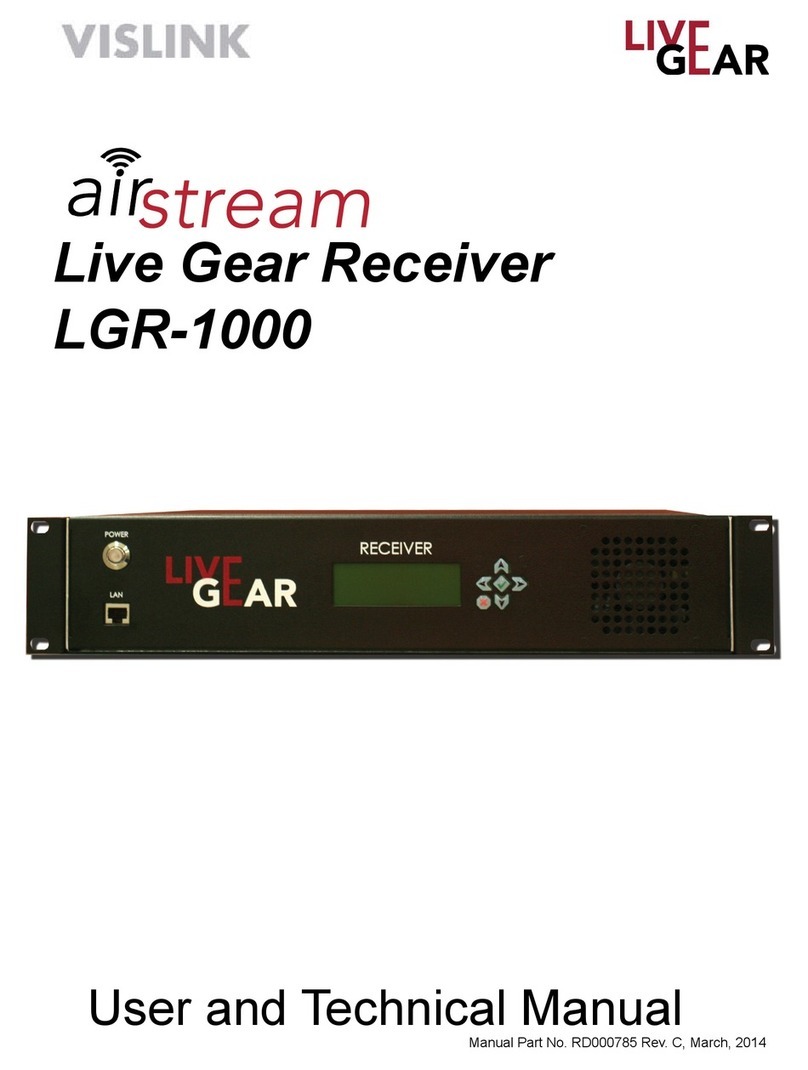
Vislink
Vislink airstream LGR-1000 User manual
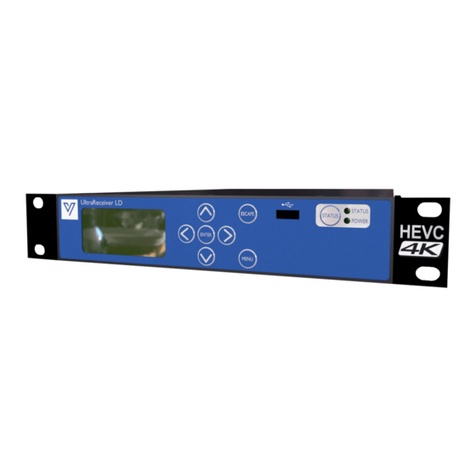
Vislink
Vislink UltraReceiver LD User manual
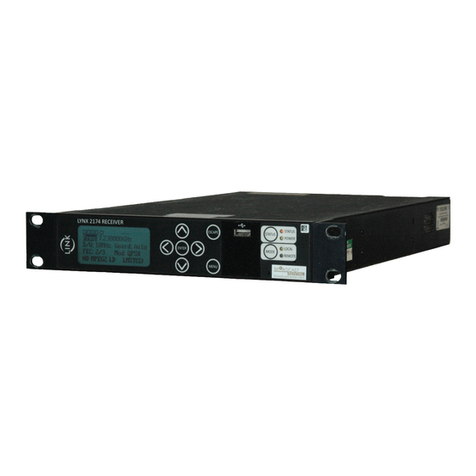
Vislink
Vislink Lynx L2174 User manual
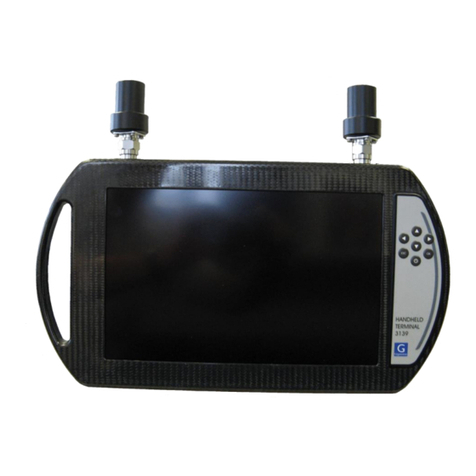
Vislink
Vislink HHT3 User manual

Vislink
Vislink Lynx L2174 User manual

Vislink
Vislink RCD9 User manual

Vislink
Vislink HDR-5000 User manual
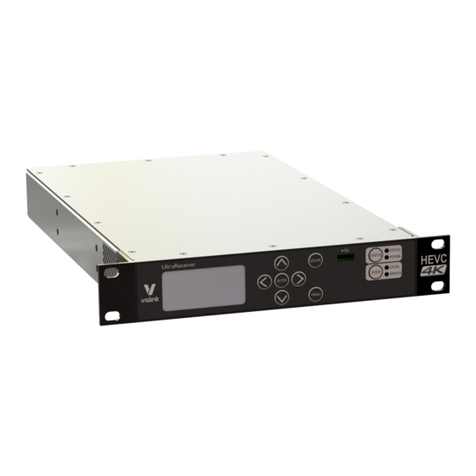
Vislink
Vislink UltraReceiver User manual
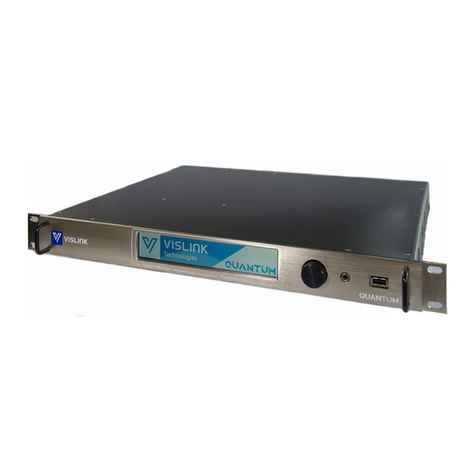
Vislink
Vislink Quantum User manual
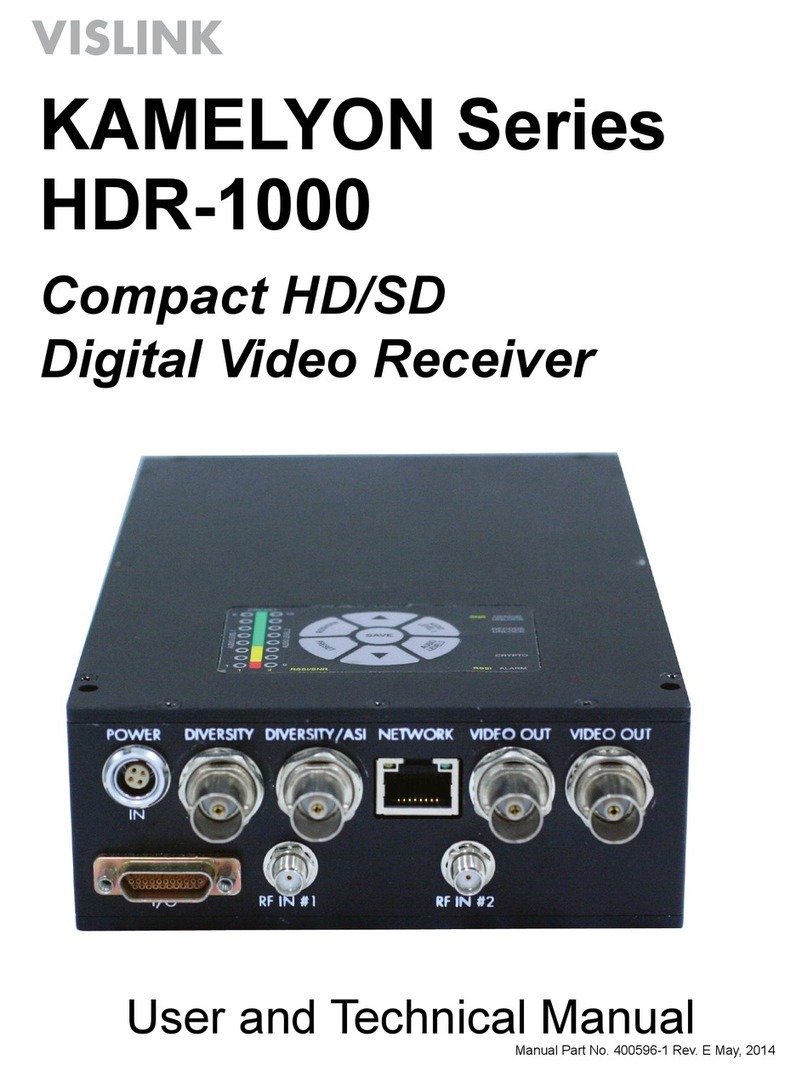
Vislink
Vislink HDR-1000 User manual
